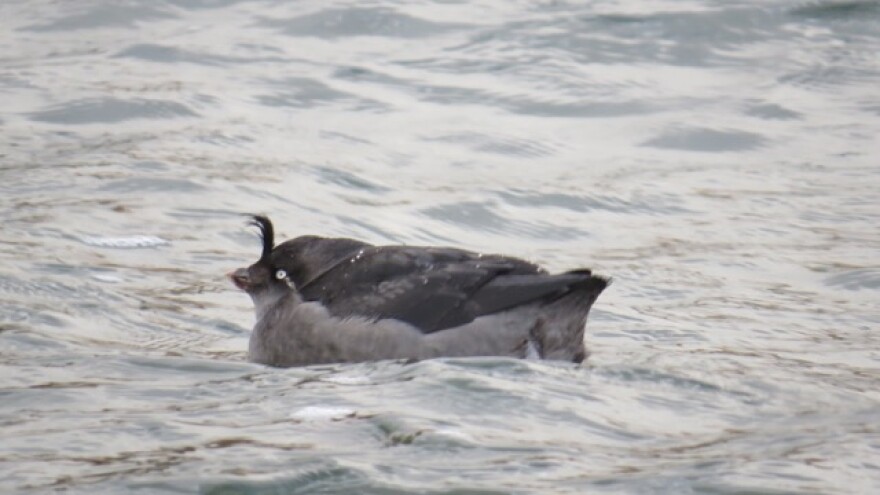Twenty one adults and five kids, in nine parties, counted birds from daylight until dusk, by foot, by car and by kayak on December 27, 2015, as part of the annual Audubon Christmas Bird Count effort. We covered a combined 36 miles of territory within the Unalaska Island Count Circle. Our count day weather was decent (having postponed while a gale whipped through) with temperatures at 39F, light southerly winds and rain holding off until afternoon. Lakes, rivers and ponds were mostly unfrozen.
The week before the count, a huge westerly storm pushed thousands of alcids into local bays from out at sea. On count day we were still seeing the results of those conditions, with Crested Auklet and Least Auklet numbers exceptionally high. The lack of snow and warm temperatures on count day had land birds scattered out, so we saw low numbers of Gray-crowned Rosy Finches, not a single Snow Bunting and only two Rock Ptarmigan.
Earlier December storms blew some mainland passerines our way, and we had high counts of Golden-crowned Sparrows and Pine Siskins. We also had a ‘ first' for our Christmas Bird Count this year, a single Golden-crowned Kinglet. A tiny thing with a brilliant yellow head streak, we've only recorded them once before in Unalaska, in the late fall of 2011. This bird showed up in mid December and has stayed tucked tight in the spruce trees of Amaknak Island ever since.
So the recent big storms across the Aleutians and our bare hills on count day explain some of our count results. But worrisome and harder to pinpoint is the reason for our lowest number ever, in twenty three consecutive years, of Steller’s Eiders. 77 is a sharp drop from an average of 500 and of concern for a 'threatened species'. The low count doesn’t look weather related because our Black Scoter count was at an all time high. These two sea ducks are quite different species, with different ranges and strategies, so who knows what is going on. Emperor Geese numbers look fairly steady. The Bald Eagle count is down by half from the glory days of the landfill, which is good, but still very high. The cool thing about all the data being online now and available for analysis is that broader trends can be seen, shifts in populations, or declines across regions, or movements of range over a decade or two. Pretty neat stuff.
Here are the results of our count. CW stands for count week birds; species not seen on count day but recorded as present in the area during the three days prior to, and three days following our count day. We tallied 49 species on count day with four additional species seen during count week. Many thanks to each and every sharp-eyed counter who was out and about that day!
Emperor Goose 1,340; Gadwall 4; Eurasian Wigeon 2; Mallard 19; Green-winged Teal 131; Canvasback 1; Greater Scaup 252; scaup species 184; Steller’s Eider 77; Harlequin Duck 1,092; White-winged Scoter 349; Black Scoter 1,165; scoter species 50; Long-tailed Duck 202; Bufflehead 57; Common Goldeneye 36; Barrow’s Goldeneye CW; Common Merganser 7; Red-breasted Merganser 120; Pacific Loon 9; Common Loon 11; Yellow-billed Loon 1; loon species 8; Horned Grebe 17; Red-necked Grebe 9; grebe species 30; Double-crested Cormorant 8; Red-faced Cormorant 1; Pelagic Cormorant 107; cormorant species 49; Bald Eagle 446; Sharp-shinned Hawk CW; Merlin 4; Peregrine Falcon 1; Rock Ptarmigan 2; Black Oystercatcher 1; Rock Sandpiper 158; Mew Gull 6; Glaucous-winged Gull 310; Black-legged Kittiwake CW, gull species 122; Common Murre 87; Pigeon Guillemot 73; Marbled Murrelet 42; Least Auklet 121; Crested Auklet 931; alcid species 5; Belted Kingfisher 9; Northern Shrike CW; Black-billed Magpie 1; Common Raven 222; Pacific Wren 7; American Dipper 4; Golden-crowned Kinglet 1; Song Sparrow 17; Golden-crowned Sparrow 6; Dark-eyed Junco 4; Gray-crowned Rosy Finch 80; Common Redpoll 8; Pine Siskin 25.
Suzi Golodoff is a local naturalist and compiler for the Christmas Bird Count.


